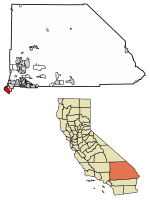Chino Hills, California facts for kids
Quick facts for kids
Chino Hills, California
|
|||||
|---|---|---|---|---|---|

Chino Hills, with the San Gabriel Mountains in background
|
|||||
|
|||||

Location of Chino Hills in San Bernardino County, California
|
|||||
| Country | United States | ||||
| State | California | ||||
| County | San Bernardino | ||||
| Incorporated (city) | December 1, 1991 | ||||
| Government | |||||
| • Type | Council-Manager | ||||
| Area | |||||
| • Total | 44.70 sq mi (115.77 km2) | ||||
| • Land | 44.65 sq mi (115.64 km2) | ||||
| • Water | 0.05 sq mi (0.12 km2) 0.15% | ||||
| Elevation | 860 ft (262 m) | ||||
| Population
(2020)
|
|||||
| • Total | 78,411 | ||||
| • Rank | 116th in California | ||||
| • Density | 1,756.13/sq mi (678.05/km2) | ||||
| Time zone | UTC-8 (Pacific) | ||||
| • Summer (DST) | UTC-7 (PDT) | ||||
| ZIP code |
91709
|
||||
| Area code(s) | 909 | ||||
| FIPS code | 06-13214 | ||||
| GNIS feature IDs | 1668255, 2409454 | ||||
Chino Hills is a city in the southwestern part of San Bernardino County, California. The name "Chino" means "curly" in Spanish. The city is close to Los Angeles County, Orange County, and Riverside County.
Contents
History of Chino Hills
Early Times
Before the Spanish arrived in the late 1700s, the Tongva people lived here. Their village, Wapijanga, was an important meeting place. It connected the Tongva with the Serrano tribe.
Spanish and Mexican Rule
After the Spanish built Mission San Gabriel in 1771, the Chino Hills area was used for cattle grazing. Later, during the Mexican era, the hills were still used for grazing by large ranches nearby.
American Settlement
This land was later sold to Richard Gird, who founded the nearby town of Chino. In the early 1900s, places like Carbon Canyon Mineral Springs and Los Serranos Country Club made the area a popular spot. Because it was a bit isolated, it also attracted people looking for a quiet place in the 1960s.
In 1991, Chino Hills officially became a city. At that time, about 42,000 people lived there.
How Chino Hills Grew
For a long time, Chino Hills was mostly countryside with rolling hills. People used the land for horse riding and dairy farms. But in the 1980s and 1990s, many new homes were built.
Today, many neighborhoods are designed like small villages. They have shopping centers and parks close by, so people can walk to them. The Vellano Country Club, with its golf course, was designed by famous golfer Greg Norman. Other large neighborhoods include Los Serranos, Butterfield Ranch, and Fairfield Ranch.
Recent Events
On July 29, 2008, a 5.4 magnitude earthquake happened in Chino Hills. It was felt far away, even in San Diego and Las Vegas. Some damage was reported, but thankfully, no one was seriously hurt.
Geography of Chino Hills
| Weather chart for Chino Hills, California | |||||||||||||||||||||||||||||||||||||||||||||||
|---|---|---|---|---|---|---|---|---|---|---|---|---|---|---|---|---|---|---|---|---|---|---|---|---|---|---|---|---|---|---|---|---|---|---|---|---|---|---|---|---|---|---|---|---|---|---|---|
| J | F | M | A | M | J | J | A | S | O | N | D | ||||||||||||||||||||||||||||||||||||
|
4
68
41
|
4.1
69
44
|
3.5
69
45
|
0.7
74
47
|
0.3
76
51
|
0.1
82
55
|
0
89
59
|
0.1
89
59
|
0.3
87
58
|
0.7
80
53
|
1.3
73
45
|
2
68
41
|
||||||||||||||||||||||||||||||||||||
| temperatures in °F precipitation totals in inches source: Weather.com / NWS |
|||||||||||||||||||||||||||||||||||||||||||||||
|
Metric conversion
|
|||||||||||||||||||||||||||||||||||||||||||||||
Land and Water
Chino Hills is part of the Chino Valley. The city covers about 44.8 square miles (115.77 square kilometers). Most of this area is made up of undeveloped rolling hills. This includes the beautiful Chino Hills State Park. Only a very small part of the city is water.
Where Chino Hills Is Located
Chino Hills is surrounded by other cities and areas. To the north and northwest are Pomona and Diamond Bar. To the east is Chino. To the south and southwest are Brea and Yorba Linda.
The eastern edge of Chino Hills is near the Chino Valley Freeway (SR 71). This freeway connects to other major roads like SR 60 and SR 91. The western border of the city is mostly undeveloped hills. This area also marks the line between San Bernardino and Orange Counties. There is only one main road, Carbon Canyon Road (SR 142), that connects Chino Hills directly to Orange County.
 |
Diamond Bar | Pomona | Chino |  |
| Diamond Bar Brea |
Chino Eastvale |
|||
| Brea Yorba Linda |
Yorba Linda Anaheim |
Corona |
People of Chino Hills
| Historical population | |||
|---|---|---|---|
| Census | Pop. | %± | |
| 1990 | 27,608 | — | |
| 2000 | 66,787 | 141.9% | |
| 2010 | 74,799 | 12.0% | |
| 2020 | 78,411 | 4.8% | |
| U.S. Decennial Census | |||
Population Growth
In 2010, Chino Hills had a population of 74,799 people. By 2020, the population grew to 78,411. Most people in Chino Hills live in homes, not in group housing.
Diversity
Chino Hills is a diverse city. In 2010, about half of the people were White. About 30% were Asian, and nearly 30% were Hispanic or Latino. The city has a mix of different cultures and backgrounds.
Households
In 2010, there were almost 23,000 households in Chino Hills. Many of these households had children under 18. The average household had about 3 people. Most homes in Chino Hills are owned by the people who live in them.
Economy of Chino Hills
Major Employers
Many people in Chino Hills work for different companies and organizations. Here are some of the top employers in the city:
| # | Employer | # of Employees |
|---|---|---|
| 1 | Chino Valley Unified School District | 3,350 |
| 2 | Costco | 340 |
| 3 | Lowe's | 265 |
| 4 | Boys Republic | 264 |
| 5 | City of Chino Hills | 229 |
| 6 | Albertsons | 226 |
| 7 | Kaiser Permanente Laboratory | 220 |
| 8 | Chino Valley Fire District | 140 |
| 9 | 99 Ranch Market | 124 |
| 10 | Harkins Theaters | 123 |
Arts and Culture
Unique Buildings
Chino Hills has an interesting building called the Egyptian Building. It looks like ancient Egyptian architecture but houses a restaurant!
City Library
The Chino Hills Library is part of the San Bernardino County Library System. The current library building opened in 2009. It is located in the city's government center.
Chino Hills in Movies
Did you know Chino Hills was a fictional setting in a famous movie? In the 1953 film The War of the Worlds, the first Martian spaceship was said to land in this area.
Parks and Recreation
Chino Hills has many parks, with 44 city parks in total. One great example is Overlook Park. It's a 1.5-acre park with amazing views of the Pomona Valley, Chino Hills, and the San Gabriel Mountains. It's a perfect spot for picnics and barbecues.
Chino Hills State Park is also a large protected area with many trails for hiking, biking, and horseback riding.
Education in Chino Hills
Students in Chino Hills attend schools in the Chino Valley Unified School District.
Elementary Schools
- Hidden Trails
- Country Springs
- Eagle Canyon
- Oak Ridge
- Butterfield Ranch
- Michael G. Wickman
- Chaparral
- Gerald F. Litel
- Glenmeade
- Rolling Ridge
- Edwin Rhodes
Junior High Schools
- Canyon Hills Junior High
- Robert O. Townsend Junior High
High Schools
- Ruben S. Ayala High School
- Chino Hills High School
- Boys Republic
Other Schools
- Loving Savior of the Hills (Independent)
- Chino Hills Christian School (Independent)
- Chino Hills Montessori School (Independent)
- Mirus Secondary School (Charter)
- Sycamore Academy of Science and Cultural Arts (Charter)
City Services
Police and Fire
The San Bernardino County Sheriff's Department provides police services for Chino Hills. The city has worked with the sheriff's department since it became a city in 1991.
Fire protection services are handled by the Chino Valley Independent Fire District (CVIFD). This district serves both Chino Hills and the city of Chino. It has its own board and operates three fire stations in Chino Hills.
Transportation
Main Roads
Several state routes pass near or through Chino Hills:
- State Route 60
- State Route 71
- State Route 91
- State Route 142
Public Transport
Chino Hills has a public transportation service called OmniLink, run by Omnitrans. It's a "dial-a-ride" service, meaning you can call to arrange a ride. It operates five days a week, mostly during the day. You can travel around the city and even transfer to the main Omnitrans bus system.
Notable People from Chino Hills
Many interesting people have connections to Chino Hills, including:
- A Static Lullaby and A Thorn for Every Heart, music bands
- LaMelo Ball, LaVar Ball, LiAngelo Ball, and Lonzo Ball, famous basketball players
- Makenzy Doniak, a professional soccer player
- Cory Harkey, a former NFL tight end
- Mike Harkey, a former Major League Baseball pitcher and coach
- Danny Lopez, a Hall of Fame boxer
- Steve McQueen, a famous actor who spent some of his teen years at Boys Republic High School
- Ricky Minor, a music director for American Idol
- Mat Mladin, a champion motorcycle racer
- Tracy Murray, a retired NBA player
- Leah O'Brien-Amico, an Olympic gold medalist in softball
- Tony Pedregon and Del Worsham, champion drag racers
- Mike Randolph and Tyler Wilson, soccer players
- Ron Roenicke, a former MLB player and manager
- Brianne Tju, an actress
- Kwame Watson-Siriboe, a soccer player
Images for kids
See also
 In Spanish: Chino Hills para niños
In Spanish: Chino Hills para niños










